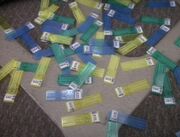mNo edit summary |
mNo edit summary Tag: sourceedit |
||
| (19 intermediate revisions by 13 users not shown) | |||
| Line 1: | Line 1: | ||
| − | [[ |
+ | [[File:Insidepadd.jpg|thumb|A PADD, showing its isolinear chip]] |
| − | [[ |
+ | [[File:Isolinear_Chips.jpg|thumb|A pile of isolinear chips]] |
| + | [[File:Shimoda plays with isolinear chips.jpg|thumb|Jim Shimoda, with a makeshift tower of isolinear chips]] |
||
| − | '''Isolinear optical chips''' (or just ''' |
+ | '''Isolinear optical chips''' (or just '''isolinear chips''') were data storage devices utilized in various forms of technology. They were used to enable [[warp drive]] in {{Class|Galaxy}} vessels, store memory in [[Starfleet]] [[PADD]]s and were a primary component of {{Class|Danube}} [[runabout]]s computers. Isolinear chips were also capable of storing [[television]] programs. ({{TNG|The Naked Now|A Fistful of Datas}}, {{DS9|The Jem'Hadar}}; {{VOY|Memorial}}) They replaced the less efficient [[duotronic enhancer]]s about [[2329|forty years prior]] to [[2369]]. ({{TNG|Relics}}) |
| − | Optical data |
+ | Optical data chips were foreseen as early as the mid-[[1990s]], and were expected to be a future development by [[Chronowerx Industries]] by the [[magazine]] ''[[Technology Future]].'' ({{VOY|Future's End}}) |
| − | They were often featured |
+ | They were often featured on board [[nanotechnology|nanotech]] processors to aid in memory access and with a maximum capacity of 2.15 [[quad|kiloquads]]. Though normally easily corrupted, chips could be coated with a layer of clear plastic for protection in environments more hostile than a [[computer core]] without affecting read and write capabilities; these strengthened chips were commonly used in [[tricorder]]s, [[PADD]]s, and other handheld devices with isolinear chip drives. ''([[Star Trek: The Next Generation Technical Manual]])'' |
| − | + | {{bginfo|According to the ''[[Star Trek: The Next Generation Technical Manual]]'', without the protective coating the user had to wear special gloves to remove the isolinear chip.}} |
|
| − | In [[ |
+ | In [[2378]], following [[Operation Watson]] when the {{USS|Voyager}} could have short periods of live contact with [[Earth]] every day, [[Neelix]] put 146 sequentially numbered isolinear chips in his hat for the crew to pull - to see in which order they would be able to contact their friends and family. ({{VOY|Author, Author}}) |
=== See also === |
=== See also === |
||
| Line 16: | Line 17: | ||
*[[Isolinear storage assembly]] |
*[[Isolinear storage assembly]] |
||
| + | ==External link== |
||
| + | * {{mbeta}} |
||
| + | |||
| + | [[ja:アイソリニア・チップ]] |
||
| + | [[ru:Изолинейный чип]] |
||
[[Category:Computer technology]] |
[[Category:Computer technology]] |
||
Revision as of 18:10, 29 April 2016
A PADD, showing its isolinear chip

A pile of isolinear chips

Jim Shimoda, with a makeshift tower of isolinear chips
Isolinear optical chips (or just isolinear chips) were data storage devices utilized in various forms of technology. They were used to enable warp drive in Galaxy-class vessels, store memory in Starfleet PADDs and were a primary component of Danube-class runabouts computers. Isolinear chips were also capable of storing television programs. (TNG: "The Naked Now", "A Fistful of Datas", DS9: "The Jem'Hadar"; VOY: "Memorial") They replaced the less efficient duotronic enhancers about forty years prior to 2369. (TNG: "Relics")
Optical data chips were foreseen as early as the mid-1990s, and were expected to be a future development by Chronowerx Industries by the magazine Technology Future. (VOY: "Future's End")
They were often featured on board nanotech processors to aid in memory access and with a maximum capacity of 2.15 kiloquads. Though normally easily corrupted, chips could be coated with a layer of clear plastic for protection in environments more hostile than a computer core without affecting read and write capabilities; these strengthened chips were commonly used in tricorders, PADDs, and other handheld devices with isolinear chip drives. (Star Trek: The Next Generation Technical Manual)
In 2378, following Operation Watson when the USS Voyager could have short periods of live contact with Earth every day, Neelix put 146 sequentially numbered isolinear chips in his hat for the crew to pull - to see in which order they would be able to contact their friends and family. (VOY: "Author, Author")
See also
External link
- Isolinear chip at Memory Beta, the wiki for licensed Star Trek works
